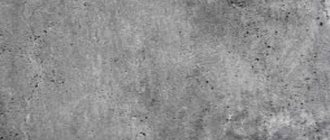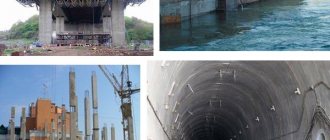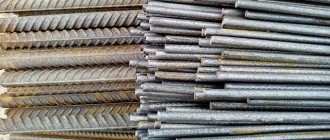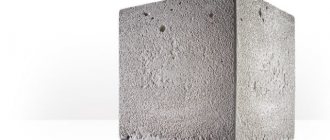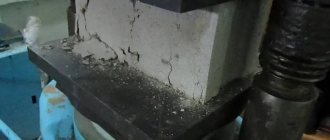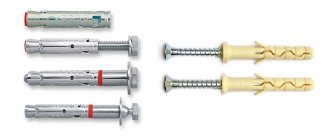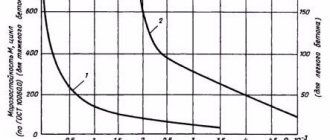Concrete M150 is used in private, multi-storey and industrial construction. It allows you to create inexpensive structures that are durable and resistant to negative climatic conditions. According to the updated labeling, this building material corresponds to concrete strength classes B10-B12.5. It is widely used for pouring foundations, erecting walls, interior partitions or other structures with limited load-bearing capacity.
Characteristics of concrete M150
Concrete mortar M150 has an average strength of 131 kgf/cm2.
After reaching the design strength, the 15x15x15 material cubes can withstand a load of 10 MPa, which corresponds to strength class B10. Brand M150 (B10) has water resistance W2-W4, frost resistance F50-F100. The mobility of the finished solution is P1, P2, P3. M150 concrete is widely used in road and housing construction. The material is used for pouring concrete paths and footings for the foundations of multi-story buildings. In private construction, B10 concrete mixture is used to construct foundations for fences, gazebos, one-story frame buildings, and outbuildings. Brand M150 is widely in demand for pouring floor screeds. In the construction industry, two types of M150 mixture are used:
- severe BST;
- light BSL.
Types of B10 concrete differ in composition and physical and operational properties: weight, density, strength.
Production technology
The process of mixing the construction mixture takes place in several stages. Strict adherence to the sequence of the technological process guarantees a homogeneous concrete composition and increases the service life of the finished product. The production of class B10 concrete has the following stages:
- preparation of all components of the solution. Rejection of components, removal of impurities that can reduce the quality of the finished solution. According to GOST 26633-91, these include particles of silicate, graphite, asbestos and coal;
- Mix the dry ingredients first. To achieve better homogeneity, gravity concrete mixers are used. This facilitates the mixing process and prevents the appearance of lumps in the finished solution;
- After pouring the solution into the mold, a vibrating plate is passed over its surface to expel air bubbles.
Strengthening process
Chemical reactions to bind all components of the mixture begin immediately after mixing begins. The process of gaining strength in the final product occurs in waves, and over time the rate decreases:
- poured concrete gains up to 60% hardness within the first 5 days;
- the concrete mixture hardens by 70% after 10 days from the date of filling the form;
- the finished product hardens completely 28 days after concreting.
To increase the strength indicators, the concrete surface is covered with a film for a month to increase the hydration period. At temperatures exceeding 25 °C, the concrete layer should be watered with water to ensure smooth progress of strength gain.
Composition of concrete M150
Heavy concrete BST with strength class B10 is manufactured in accordance with GOST 26633-2015. The composition includes components:
- cement M400 or M300;
- gravel crushed stone with a fraction size of 5-20 mm;
- quarry sand with a fraction size of 1.5-2 mm;
- technical water.
When mixing lightweight concrete BSL according to GOST 25820-2014, the components of the mixture will be the following:
- cement M400 or M300;
- large porous aggregate;
- construction sand;
- technical water.
The following coarse aggregates are used: expanded clay, shungesite, agloporite, slag pumice gravel or crushed stone, as well as glassy porous fillers, glass sand granulate, foam glass, pumice, tuff, volcanic slag, thermolite, expanded vermiculite.
Composition and proportions
- Cement grades M400-M500;
- fine aggregate – medium sand;
- coarse aggregate - crushed stone. Crushed stone made from gravel or limestone is most often used due to its more affordable price. Granite only increases the price per cubic meter of building mixture;
- water without impurities.
| Cement brand | Cement | Sand | Crushed stone |
| M400 | 1 | 3,8 | 5,7 |
| M500 | 1 | 4,5 | 6,6 |
Proportions of concrete mixture M150
Compared to other brands, M 150 has a minimal cost due to the fact that it contains a small amount of cement binder. To produce class B10 material, Portland cement M400 or M300 is used. The use of higher grades is impractical.
The proportions of the concrete mixture will be as follows:
- Portland cement M400 - 1 hour;
- quarry sand - 3.5 hours;
- coarse filler - 5.7 hours;
- water for mixing - 0.5 tsp.
When using Portland cement M300, the ratio of sand and coarse filler will be 4.6 and 7, respectively.
Areas and features of application
Low strength indicators limit the use of class B10 concrete. Works that are suitable for pouring mortar with the following characteristics:
- a concrete layer leveling the soil before pouring the strip foundation and monolithic slab;
- substrate for the base of roads with low traffic capacity;
- installation of curbs;
- concreting the bases of pillars and fences;
- pouring the pool pit in front of the main layer of concrete that does not allow moisture to pass through
Class B10 concrete is an excellent choice for a contractor who wants to prepare a construction site for the main pour and stay within budget.
How much does lightweight concrete M150 weigh?
When using lightweight porous aggregates, the weight of 1 cubic meter of solution will be less. Comparison of the weight of heavy concrete on gravel with light types of concrete mixture:
| Concrete mix M150 by type of coarse aggregate | Weight of 1 m3 of concrete mixture, kg |
| Heavy concrete (HCT) | 2400 |
| Vermiculite concrete | 500-700 |
| Tufobeton | 1200-1300 |
| Ash concrete | 500-800 |
| Pumice concrete | 800-1200 |
| Agloporite concrete | 1100-1500 |
| Expanded clay concrete | 800-1000 |
| Cinder concrete | 1200-1600 |
| Shungazi concrete | 100-700 |
| Thermozite concrete | 1000-1600 |
| Perlite concrete | 1000-1100 |
The exact weight of the material can only be calculated by the manufacturer based on the Technical Specifications.
Application
Since the strength properties of concrete B 10 are low, its scope of application is determined by its capabilities. Typically M150 concrete mass is used for:
- preparation devices for finished floors made of other materials, as well as creating a concrete coating in rooms with very little load on the floor, for example, a basement, cellar or garage;
- embedding voids during the construction of buildings made of reinforced concrete or concrete blocks, panels;
- production of individual fencing parts, curb stones, some garden and interior decor items;
- strengthening fence posts;
- laying the underlying layer under strip, columnar, slab foundations.
Concrete grade M150 B10 can be used in the construction of structures that during operation will not be subject to large static or any dynamic loads.
Weight of 1 m3 of concrete after curing
The mass of the concrete structure after reaching its design strength may differ from the normalized design mass of the mortar. Weight changes are associated with the following factors:
- water-cement ratio in the initial mixture;
- the presence of chemical additives in the composition;
- delivery range of construction mixture;
- indicators of water retention and air circulation;
- temperature at which monolithic work was carried out;
- configuration, weight of a monolithic structure;
- conditions for gaining design strength;
- quality of care for the monolith during the period of strengthening.
During the construction of large objects, where the M 150 grade is used for auxiliary monolithic work, an accurate calculation of the mass is made. In private construction, the change in the mass of the material after hardening can be neglected without compromising the strength of the structure.
Return to list
Properties of concrete 10
Heavy concrete of this category has not only low strength, but also insignificant indicators of resistance to moisture and low temperatures. These properties predetermine its importance in construction production and areas of use. Along with other grades, concrete B 10 must meet GOST 26633-2012 “Heavy and fine-grained concrete. Technical specifications" and other regulatory documents. Failure to comply with these requirements will certainly lead to devastating consequences.
The technical characteristics that are inherent in M150 B10 concrete are outlined below:
| Index | Unit change | Standard |
| Compressive Strength | MPa | 13 |
| Same | kgf/cm2 | 150 |
| Tensile strength | MPa | 1 |
| Density | kg/m3 | 2100 |
| Waterproof | brand | W2 |
| Frost resistance | F50 | |
| Workability | P2-P3 |
The volumetric weight of B10 concrete is in the range of 1800-2100 kg/m3, depending on the quality of the crushed stone used, in addition to which, as usual, cement and sand are used to prepare this material. Plasticizing, antifreeze, and hardening-accelerating additives are also not excluded.
The following requirements apply to raw materials:
- There is no reason to use high-grade cement, since too little binder consumption will make it impossible to prepare a homogeneous mixture. Therefore, cement grades M200-M400 are best suited.
- Sand should be taken clean and of medium coarseness.
- Almost any crushed stone or a mixture of different rocks can be used. But most often gravel or lime material is used; gravel on its own or as part of a sand-gravel mixture is also suitable. The preferred fraction is 5-20 mm, crushability grade is from M300 to M600.
If you use granite crushed stone, then it will not make significant changes to the properties of M150 B10 concrete, but will significantly increase the cost.
Advantages of ordering the solution from us
All you need to order M150 concrete in Moscow is to contact our company in any convenient way. Next, managers will promptly accept the order. If necessary, they will consult. After which delivery will be arranged.
Let us note that we have been working in this industry for quite a long time. For this reason, we have extensive experience, which allows us to professionally fulfill every order. What is important is that we work with clients on an individual basis. At the same time, we fully take into account the requirements and wishes.
Advantages of brand 150
Despite the insufficiently high strength characteristics and certain restrictions on the scope of use, a solution marked M150 has certain advantages:
- reasonable price. Due to the low cost of purchasing this building material, the total cost of construction activities is reduced;
- reliability. Under the influence of temperature fluctuations and humidity deviations, the concrete mass does not collapse;
- long service life. If the manufacturing technology is followed, the monolith retains its properties for a long period;
- environmental cleanliness. Environmentally friendly ingredients are used to make concrete mortar.
By deciding to use M150 concrete mortar to perform certain construction tasks, you can save money. After all, the mixture is easy to make on your own at a construction site.
Classification of concrete by grade
Concrete grade by strength
To determine the strength, cubic samples of material with an edge of 150 mm are used, which dry naturally for 28 days. Afterwards they are subjected to compression and the grade is determined by strength. There are grades from M50 to M1000, which differ in their scope of use and properties:
- M50–M100
is the weakest material that is suitable for plastering walls, filling voids in structures that are not subject to heavy loads, for example, when carrying out preparatory work for laying road surfaces, footings for foundations. - M100–M150
- suitable for pouring under the main foundation, installing curbs, pouring low-traffic paths, platforms, terraces, floor screeds and constructing structures that will not be subject to high loads. - M200–M250
is a more durable material that is suitable for making concrete floors, flights of stairs, curbs, paths, and blind areas. It can be used to build a strip foundation if the groundwater is low and the soil is stable. - M300
is the best concrete for foundations and monolithic construction of low-rise buildings. It makes strong retaining walls, fences and stairs. They are used to fill playgrounds and paths, which last a long time due to their strength and resistance to moisture. - M350
- can withstand heavy loads, therefore it is suitable for the manufacture of monolithic foundations and walls of multi-storey buildings, floors, columns and other reinforced concrete products, swimming pool bowls. - M400–M550
is a very durable material for the construction of bridges, dams, runways, and bank safes.
Correspondence table for concrete grades and classes
| Concrete class (B) for compressive strength | The closest concrete grade (M) in terms of compressive strength | Average strength of concrete class kgf/cm² |
| B3.5 | M50 | 45,84 |
| AT 5 | M75 | 65,48 |
| B7.5 | M100 | 98,23 |
| AT 10 | M150 | 130,97 |
| B12.5 | M150 | 163,71 |
| B15 | M200 | 196,45 |
| IN 20 | M250 | 261,94 |
| B22.5 | M300 | 294,68 |
| B25 | M350 | 327,42 |
| B27.5 | M350 | 360,16 |
| B30 | M400 | 392,90 |
| B35 | M450 | 458,39 |
| B40 | M500 | 523,87 |
| B45 | M600 | 589 |
| B50 | M650 | 655 |
| B55 | M700 | 720 |
| B60 | M800 |
Concrete grade for water resistance
The finished composition contains pores into which water and air enter. The smaller the pores, the more water resistant it is. According to water resistance, concrete is marked with the letter “W” with a numerical indicator of water resistance:
- W2, W4
- the highest permeability, so it is only suitable for interior work and construction where waterproofing is not needed; - W6
- reduced permeability, structures absorb an average amount of moisture, so the solution is suitable for most jobs; - W8
- low permeability, the mixture is used for objects with high waterproofing, including when finishing swimming pools; - W10–W20
- high resistance to moisture, which allows the solution to be used for complex hydraulic structures.
Concrete grade for frost resistance
Frost resistance is designated by the letter “F” with a numerical value from F25 to F1,000. To determine frost resistance, samples of the mixture are subjected to freezing and thawing until the strength is at least 95%:
- below F50
are used indoors only; - F50–F150
have frost resistance sufficient to create objects in a temperate climate; - F150–F300
are suitable for the construction of structures in climates with harsh winters; - F300–F500
are used for objects with variable water levels, for example, hydraulic structures at sea. - more than F500
is used very rarely, when it is necessary to build an object that will serve for more than a century.
The frost resistance indicator is especially important for construction on very wet soils, for the construction of bridges, when temperature changes have a negative impact on the structure.
Table: frost resistance and water resistance of concrete
| Class | Brand | Waterproof | Frost resistance |
| B3.5 | M50 | W2 | F50 |
| AT 5 | M75 | W2 | F50 |
| B7.5 | M100 | W2 | F50 |
| AT 10 | M150 | W2 | F50 |
| B12.5 | M175 | W4 | F50 |
| B15 | M200 | W4 | F100 |
| IN 20 | M250 | W4 | F100 |
| B22.5 | M300 | W6 | F200 |
| B25 | M350 | W8 | F200 |
| B27.5 | M350 | W8 | F200 |
| B30 | M400 | W10 | F300 |
| B35 | M450 | W8-W14 | F200-F300 |
| B40 | M550 | W10-W16 | F200-F300 |
| B45 | M600 | W12-W20 | F100-F300 |
| B50 | M650 | W12-W20 | F100-F300 |
| B55 | M700 | W12-W20 | F100-F300 |
| B60 | M800 | W12-W20 | F100-F300 |
Material grades
It is the brands (which are designated by the letter “M”) that are destined to determine how high quality the concrete is.
And this depends on two factors: the ratio of water and cement, as well as the quality of the binding components used.
Brands are directly related to classes. Next, we will talk about the composition of the material of each brand (prices and applications are similar to the corresponding classes).
M100
One of the popular and cheap materials is “skinny” concrete. Corresponds to class B7.5. Has a density from 2370 to 2400 kg/m3. When using granite crushed stone, the characteristics are better than with limestone crushed stone. To make concrete, 7 parts of crushed stone and 4.6 parts of sand are added to one part of cement.
M150
This brand corresponds to classes B10, B12 and B12.5. When making concrete of this type, 5.7 parts of crushed stone are combined with one part of cement and 3.5 parts of sand. As a rule, a plasticizer is not added.
We’ll talk further about the most popular brand of heavy concrete, class B15-m200, its technical characteristics, GOST and price.
M200
This brand corresponds to class B15. Its volumetric mass is 2400 kg/m3. Mobility – from P2 to P4 (increases with the addition of plasticizers). To make the mixture, one part of cement will require 2.8 parts of sand and 4.8 parts of crushed stone.
The following video will tell you how M200 concrete is restored:
M250
The brand corresponds to class B20. It has a density of 2390 kg/m3, mobility - P3. For one part of cement you will need 4.5 parts of crushed stone and 2.6 parts of sand. GOST provides for the mandatory addition of a plasticizer in the amount of 5.8 kilograms per cubic meter of mixture.
M350
The brand corresponds to class B25, which is considered elite. It has mobility from P2 to P4 (the plasticizer can increase it to P5), density - 2395 kg/m3.
One cubic meter of concrete is made from a ton of crushed stone (granite or gravel), 752 kilograms of clean sand, 400 kilograms of cement and 175 liters of water.
Concrete grade 150 - proportions
The production of the composition of the M150 brand can be carried out both in industrial and at home conditions. The main thing is to ensure uniform mixing of all ingredients, as well as maintain the necessary proportions to obtain a composition with the required parameters. The percentage of components is calculated taking into account various factors - particle size of crushed stone and sand, density, brand of cement used.
When making concrete mortar marked M 150, the following recommendations should be followed:
- Portland cement grade M400 must be mixed with crushed stone and sand in a mass ratio of 1:5.7:3.5. For volumetric dosing, mix 32 liters of sand with 50 liters of crushed stone and add 10 liters of cement. The result will be 62 liters of concrete mixture;
- Using cement marked M500, you need to take 6.6 kg of crushed stone per 1 kg of cement and mix the ingredients with 4.5 kg of sand. The volumetric proportion involves mixing 10 liters of cement with 40 liters of sand and 58 liters of crushed stone. This allows you to get 73 liters of solution.
The decision to use the volumetric method of measurement or weighing the components for preparing a concrete mixture is made individually. Both methods provide the required performance characteristics of the monolith, provided that high-quality components are used.
Due to its low price and good properties, it has gained popularity among other brands of concrete mortars

